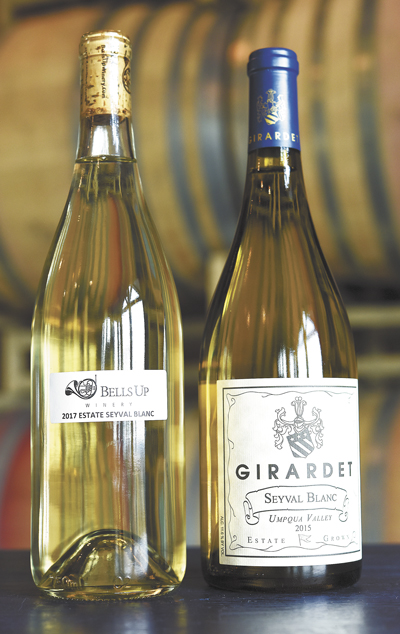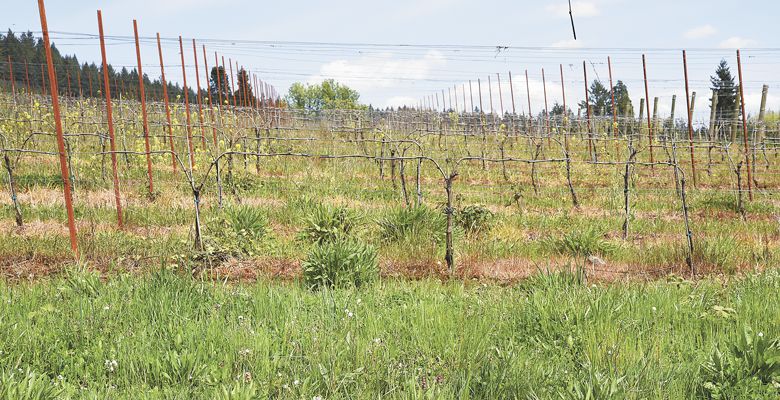Seyval Blanc
Two Oregon wineries grow hybrid
Much like the universe, opportunities for growing wine grapes in Oregon seem virtually limitless and ever-expanding. Where Oregon’s wine world has been seemingly constrained by its shining stars —Pinot Noir, Chardonnay and even Pinot Gris and Riesling — it is currently expanding to include a host of interesting and more unusual wine grapes.

Enter Seyval Blanc.
Seyval Blanc is the belle of the ball all along the eastern seaboard, from the Carolinas deep in the south, all the way north to Nova Scotia. Try to find a winery in New York’s Finger Lakes region that doesn’t produce a Seyval. Its popularity also spreads to Missouri, Michigan, Wisconsin, Canada, England and, yes, even as far west as Oregon.
Budding and ripening early, Seyval Blanc is ideal for cool climates. The grapes typically produce a crisp, dry wine with a lean body, citrusy grapefruit notes, green apple and the fresh smell of hay. Plus, depending on where it’s grown, minerality similar to white Burgundy is not uncommon. In warmer vintages, however, the wine expresses peach, apricot and tropical flavors, such as ripe, juicy melon.
When I asked Marc Girardet, winemaker of the eponymous Southern Oregon winery, to compare Seyval Blanc to other varietals, he said, “I don’t feel like it has a direct comparison. With its naturally high acidity, the flavors tend to be along the bright lemon/grapefruit spectrum, with a delightfully smooth mouthfeel, like lemon meringue pie in a wine.”
Marc’s parents, Philippe and Bonnie Girardet, were the first to plant Seyval Blanc, in the Umpqua Valley in 1982. “I was only seven, but I remember helping plant the vines,” Marc said. “It was part of a collection of several French-American hybrid varieties that my parents picked up in New York State. The goal was to experiment with unique varieties that could make off-the-beaten-path wines and that could be grown organically, without the need for a spray program for powdery mildew.”
Philippe bottled several vintages of Seyval Blanc in the 1990s, and Marc remembers customers raving about it, saying it was “the best white wine they’d ever tasted.” For reasons unknown to him, the estate Seyval was primarily used in a white blend his father made. In 2011, after Marc had been in charge of winemaking for several years, he brought their Seyval Blanc back as a varietal bottling for the first time since the ’90s. They now produce about 50 cases a year sold in the tasting room to a small but loyal following.
Marc says Seyval seems at home in the southern Umpqua, thriving with their higher elevation (800 feet), low -vigor soils, cold nights and warm days, producing what he describes as an Alsatian-style white wine. But Seyval does really well in warmer years as well because it has great acidity and the sugar levels are slow to rise.
So why is Seyval Blanc slow to take hold and become entrenched in Oregon’s wine culture? It could be because it lacks “snob appeal” due to its hybrid nature and it’s not one of the noble grapes but more of a “working class” grape.
Marc says, “For the lucky few enjoying it on a local level, it is a fantastic, unique wine that has a great niche in Oregon, and it fits with our sustainable, creative story.”
In addition to Girardet, only one other Oregon producer is growing and producing Seyval Blanc: Bells Up in the Chehalem Mountains AVA of the Willamette Valley.
In 2015, Dave and Sara Specter sourced 200 cuttings from a qualified nursery in New York to plant on their estate vineyard. Some were grafted on American rootstock, some on their own original rootstock. Because of its hybridization, phylloxera should not be an issue. In fact, Seyval Blanc is a cross between two different clones of Seibel, initially developed for its phylloxera-resistant properties.
Sara’s been working on her own experiment: the propagation project. She took 50 cuttings off the small Seyval vines they purchased and planted them in nursery pots; they sit in her kitchen window. Despite her “black” thumb — she has a history of dead house plants — the young vines are taking root and producing buds. Next spring, after 18 months inside, the Specters will plant them in the vineyard.
The Specters now farm more than 250 Seyval vines. They grow in the section receiving the most intense sun. They’re interested to see if the cooler-climate grape might develop more complexity in warmer vintages. The “project” is still an experiment for Bells Up. Dave says, “I like what I see so far, but it’s up to Mother Nature to see how it goes.”
But why did the couple from Cincinnati plant the hybrid in Vinifera-fertile Oregon?
“We chose it because if you are going to play around with different varietals in the Willamette Valley, the space to do that is with the whites, plus we have a history with it.”
Dave won two national amateur winemaking competitions, two months apart in 2011. One of the winners was a Seyval Blanc.











